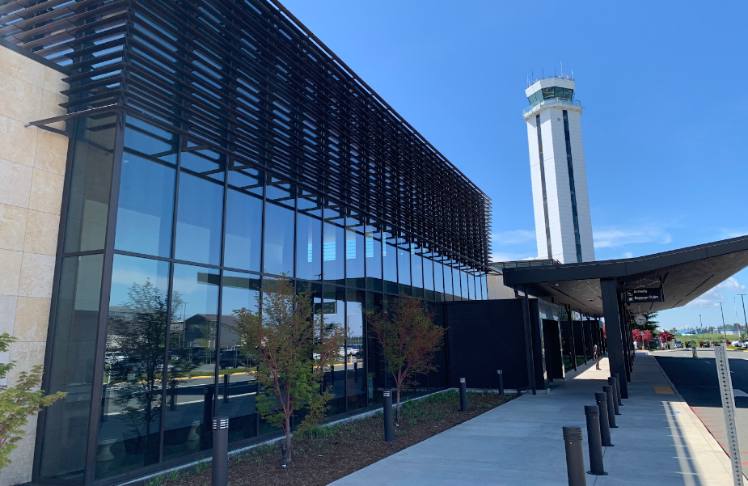![]()
Research and development ventures have landed around Seattle Paine Field Airport, soaking up industrial space as fast as it can be built.
Less than 4% of the industrial space in the North End market sat vacant at the end of the second quarter, according to commercial real estate services company JLL, spurring the construction of several speculative new projects as developers place bets on the demand continuing.
Along with market conditions that have pushed industrial uses north from King County, young companies are seeking space in the orbit of the Boeing Co.’s largest manufacturing center and tapping into new energy technologies like hydrogen, biofuels and even nuclear fusion, said Gabe Smith, vice president of JLL.
“The deep aerospace aviation talent pool in and around Paine Field because of the generations of Boeing work there — you have this unique blend of that type of talent and tech talent coming out of Seattle,” Smith said.
That includes a $5.5 million R&D center built by ZeroAvia in 2022 and a $6.5 million state-sponsored venture to build a repository and research facility for sustainable aviation fuels.
Also in close proximity are Everett-based MagniX, which builds electric power trains for small aircraft, fusion power ventures Helion Energy and Zap Energy, and Woodinville-based Modern Hydrogen, which strips carbon from natural gas for hydrogen power. All told, more than 55 aerospace, energy and related companies have set up shop in the area from outside the state, with more on the way, Smith said.
“You have a really nice complementary blend of businesses that can all work in close proximity to one another and collaboratively,” he said.
That’s put upward pressure on prices and forced companies to move more quickly than they often expected, said Wendy Poischbeg, vice president of economic development for Economic Alliance Snohomish County.
Industrial real estate prices have risen 11.5% across the region in the past year, JLL said in a second-quarter market analysis, which calculated manufacturing space in the North End market at around $1.17 per square foot. Companies that have hesitated have found that they’ve had to pay more than they initially planned or move farther out toward Marysville or Arlington, Poischbeg said.
“Things that were non-negotiable a year ago are negotiable today,” she said. “This is an ecosystem that the folks that have always been in aerospace and the ones that have diversified are continuing to grow and expand.”
Other markets like Bothell and Monroe have even tighter supply, as industrial areas have been converted into housing, retail and office spaces, said Brent Jackson, senior vice president with JLL. That’s pushed even more industrial demand north and prompted builders to launch new projects with no preleases in place.
“These landlords, developers, investors are bullish on the market to the extent that they’ll go ahead and build these buildings without a tenant,” Jackson said.
Vacancy rates had been even lower last year, near 2%, before some of the new spaces came online in Marysville and Arlington, and another 1.65 million square feet are expected to be delivered between September and June 2024. Those include projects like the Gayteway Business Park, Northsound Industrial Park and the BridgePoint Soundview project, among others.
North End by the numbers:
- Industrial vacancy rate: 3.5%
- Manufacturing vacancy rate: 3%
- Manufacturing price per square foot: $1.17
- Year-over-year price increase (Puget Sound region): 11.5%
But there’s a limit to how much they can build, Jackson said. The area is constrained by green space and slopes that make new development challenging.
“It’s a fairly mature market. A lot of development has already occurred, so what’s available is limited, infill-type sites for redevelopment,” he said. “After those are done, plus the ones that are actually under construction now, there’s not a whole lot more space or land to develop.”
And with companies chasing aerospace workers that already live in the North End, the barrier to continued growth won’t just be on the industrial side. Though housing prices aren’t as high as Seattle or Bellevue, affordable options for workers are a key condition for further growth, Poischbeg said.
Seattle Paine Field Airport is looking to clear the way for more industrial development. It’s in the process of acquiring three properties from the Air National Guard and has demolished the former YMCA building, seeking to make those parcels site-ready for new construction. It is also looking to build out a 120-acre parcel on the west side of the runway.
“If we had more buildings, we could fill them,” said Terry Ryan, aerospace economic development director for Snohomish County, which operates the airport. “It’s everything from manufacturing to offices for engineering and design.”
With development costs and interest rates still supportive of new projects, the airport also expects additional hangars, support services and amenities to come online at its general aviation runway.
“The easiest sites to develop have mostly been developed, so right now we’re trying to get those more challenging sites ready,” said Paine Field Business Manager Nick Landgraff.
